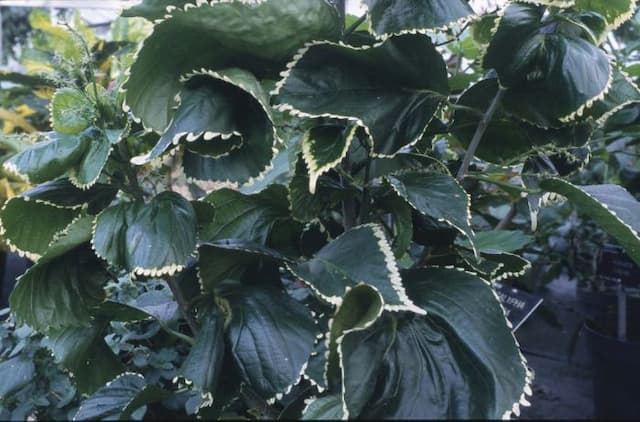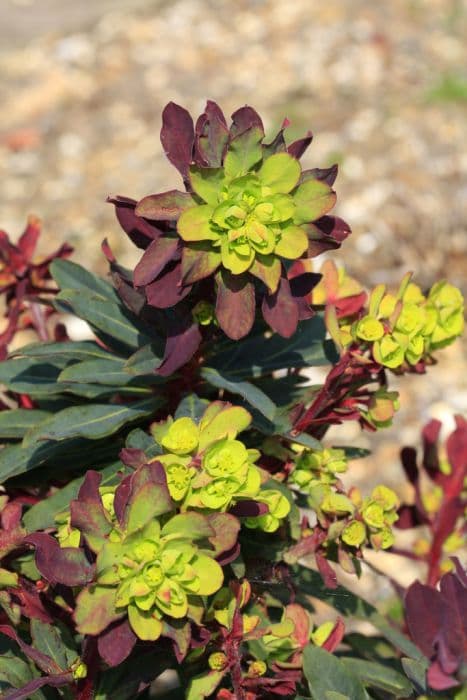Mediterranean Spurge Euphorbia characias subsp. wulfenii 'Emmer Green' (v)

ABOUT
The Euphorbia characias subsp. wulfenii 'Emmer Green' (v), commonly known as Mediterranean Spurge 'Emmer Green', is a visually striking plant. It possesses a dense, bushy habit with branches that are erect and sturdy. The stems are crowned with whorls of blue-green leaves that have a unique, cylindrical shape, giving the plant a somewhat architectural appearance. The leaves are fleshy with a matte texture, and they may have a subtle, pale line down the center, adding to their sculptural quality. This variegated form of Mediterranean Spurge often has lighter edges on its leaves, providing a pleasant contrast and adding depth to the foliage. What really draws the eye, however, are the distinctive flowering clusters. The inflorescences consist of cup-shaped bracts that are lime green to bright yellow-green in color, creating a vivid display in the spring and early summer. The actual flowers are tiny and not particularly noticeable, nestled within the showy bracts. The overall visual impact of Mediterranean Spurge 'Emmer Green' is one of structure and texture, with its combination of upright growth, cylindrical blue-green leaves, and vibrant flower clusters. It adds a bold statement to garden compositions, with its foliage providing year-round interest and its flowers adding a splash of seasonal color.
About this plant
 Names
NamesFamily
Euphorbiaceae
Synonyms
Mediterranean Spurge, Wulfen Spurge
Common names
Euphorbia characias subsp. wulfenii 'Emmer Green'
 Toxicity
ToxicityTo humans
Mediterranean Spurge, including the variety Euphorbia characias subsp. wulfenii 'Emmer Green', is toxic to humans. All parts of the plant contain a white, milky sap known as latex, which is particularly harmful. If the sap comes into contact with skin, it can cause irritations and allergic reactions. If it gets into the eyes, it can cause severe pain and temporary blindness. If ingested, the latex can cause nausea, vomiting, and diarrhea. Ingestion can also lead to more severe symptoms such as difficulty swallowing, swelling of the tongue, and effects on the nervous system.
To pets
Mediterranean Spurge is also toxic to pets. The latex from the plant can cause similar issues as in humans. If your pet comes into contact with the sap, they may experience skin irritation and allergic dermatitis. If the sap gets into the eyes of the animal, it can result in eye pain and possibly temporary or even permanent blindness. Ingesting parts of this plant can cause vomiting, diarrhea, and other gastrointestinal problems. In some instances, it can lead to more severe symptoms which include difficulty breathing or swallowing, and systemic involvement that could be life-threatening. Owners should take care to prevent their pets from having access to or ingesting any part of this plant.
 Characteristics
CharacteristicsLife cycle
Perennials
Foliage type
Evergreen
Color of leaves
Blue-green
Flower color
Yellow-green
Height
4 feet (1.2 meters)
Spread
3 feet (0.9 meters)
Plant type
Shrub
Hardiness zones
8
Native area
Mediterranean
Benefits
 General Benefits
General Benefits- Easy Maintenance: Euphorbia characias subsp. wulfenii 'Emmer Green' is known for being easy to care for, requiring minimal attention once established.
- Drought Tolerant: This plant is highly drought-resistant, making it ideal for xeriscaping and gardens in arid climates.
- Year-Round Interest: It offers a long period of interest throughout the year, with evergreen foliage and striking blooms in the spring.
- Attracts Pollinators: The bright flowers attract bees and butterflies, promoting biodiversity in the garden.
- Architectural Form: Its upright, structural form adds architectural interest to landscape design and can act as a focal point.
- Deer Resistant: It is not generally favored by deer, which makes it a good choice for gardens in areas with deer pressure.
- Versatility in Landscaping: Can be used in borders, rock gardens, or as a stand-alone specimen, showcasing its adaptability in different garden settings.
- Low Fertilizer Needs: It typically does not require additional fertilizing, thriving in poor to moderately fertile soils.
- Erosion Control: The plant can help in controlling soil erosion due to its root structure.
 Medical Properties
Medical PropertiesThis plant is not used for medical purposes.
 Air-purifying Qualities
Air-purifying QualitiesThis plant is not specifically known for air purifying qualities.
 Other Uses
Other Uses- Photography backdrop: Euphorbia characias 'Emmer Green' can provide a stunning green backdrop for macro or plant photographers looking for textural contrast.
- Artistic inspiration: The unique form and color of the plant can be used by artists as a subject for paintings, drawings, or mixed media art.
- Educational tool: Schools or environmental organizations might use this plant to teach about drought-tolerant gardening and Mediterranean flora.
- Dye source: The sap of the Mediterranean spurge could potentially be used to create a natural dye for textiles, though caution is needed due to its irritant nature.
- Living sculptures: Pruned and shaped over time, the plant can be turned into a living sculpture for garden art and topiary.
- Insect habitat: The plant's structure provides shelter for beneficial insects, supporting biodiversity in a garden ecosystem.
- Garden border definition: Mediterranean spurge can be used to create clear and aesthetically pleasing boundaries between different garden sections.
- Seasonal interest: The plant's evergreen nature and winter blooming period can add color and interest to gardens during the colder months.
- Theme gardens: This euphorbia is suitable for xeriscape or Mediterranean-themed gardens, emphasizing water conservation and regional planting.
- Soil erosion control: Its dense growth habit can help stabilize soil on slopes, reducing erosion in dry climate areas.
Interesting Facts
 Feng Shui
Feng ShuiThe Spurge is not used in Feng Shui practice.
 Zodiac Sign Compitability
Zodiac Sign CompitabilityThe Spurge is not used in astrology practice.
 Plant Symbolism
Plant Symbolism- Resilience: Euphorbia characias subsp. wulfenii, commonly known as Mediterranean Spurge, is known for its ability to thrive in harsh and dry conditions, symbolizing resilience and the capacity to endure challenging environments.
- Protection: The milky sap of the Mediterranean Spurge has been historically used as a deterrent for pests and can cause irritation when in contact with skin, leading to its association with protection and defense.
- Persistence: Mediterranean Spurge has a persistent nature, as it can self-sow and spread quite effectively. This trait symbolizes an individual's determination and tenacity in life.
- Uniqueness: With its distinctive structural form and unique greenish-yellow flowers, the Mediterranean Spurge stands out from other plants, symbolizing the beauty of being unique and embracing individuality.
 Water
WaterMediterranean Spurge should be watered thoroughly, allowing the top layer of soil to dry out before subsequent waterings. This drought-tolerant plant prefers less frequent waterings, so a general rule is to water approximately once every one to two weeks, depending on the climate and soil drainage. Use a watering can or hose to gently water the plant at the base, avoiding wetting the foliage to prevent disease. The amount of water needed might range from half to one gallon per watering session during the growing season, reducing frequency in the colder months.
 Light
LightMediterranean Spurge thrives in full sun to partial shade conditions. The ideal spot for this plant is in an area where it can receive at least six hours of direct sunlight per day. Too much shade can result in a leggy plant with reduced flower production, so place it in a location where it will have ample access to bright light.
 Temperature
TemperatureMediterranean Spurge does well in a wide range of temperatures, making it quite versatile. It can handle temperatures as low as 30°F, surviving short periods of frost, and it can flourish in temperatures up to around 90°F. The ideal temperature range for Euphorbia characias subsp. wulfenii 'Emmer Green' is between 60°F and 75°F.
 Pruning
PruningPruning Mediterranean Spurge is necessary to maintain its shape and encourage new growth. It's best to prune after the plant has finished flowering in late spring or early summer. Cut back the spent flower stems to the base to tidy up the plant and stimulate new growth. Be cautious when pruning, as the sap can be irritating to the skin and eyes.
 Cleaning
CleaningAs needed
 Soil
SoilMediterranean Spurge requires well-draining soil with a slightly alkaline pH between 7.0 and 8.0. A mix of one part sand or perlite, one part garden soil, and one part peat or compost would create an ideal growing medium for this robust plant.
 Repotting
RepottingMediterranean Spurge is a relatively slow grower and does not need frequent repotting; it should be repotted every two to three years or when it outgrows its current container.
 Humidity & Misting
Humidity & MistingMediterranean Spurge is tolerant of a wide range of humidity levels and does best in average room humidity conditions; it does not require high humidity.
 Suitable locations
Suitable locationsIndoor
Ensure bright light, low humidity, and infrequent watering.
Outdoor
Plant in full sun with well-draining soil and space for growth.
Hardiness zone
7-10 USDA
 Life cycle
Life cycleEuphorbia characias subsp. wulfenii 'Emmer Green' (v), commonly known as Mediterranean Spurge, begins its life cycle as a seed, which germinates in spring when soil temperatures are warm enough. The seedling grows into a robust, evergreen perennial plant with erect stems and narrow, blue-green leaves, reaching maturity in 2 to 5 years. Mediterranean Spurge blooms in late winter to early spring, showcasing cylindrical clusters of chartreuse-green flowers with a central purple eye. After flowering, the plant sets seed, which are distributed by wind or animals to begin a new cycle. Over time, the parent plant may become woody at the base and, if not pruned or managed, can become leggy. Mediterranean Spurge has a long lifespan and can thrive for many years if it is grown in well-drained soil and a sunny location, with older plants often rejuvenating by producing new shoots from the base.
 Propogation
PropogationPropogation time
Spring-Early Summer
The Euphorbia characias subsp. wulfenii 'Emmer Green', commonly known as Mediterranean Spurge, is primarily propagated through seed or by taking cuttings. The most popular method among gardeners is vegetative propagation via cuttings. This is done by snipping off a healthy piece of the plant, making sure that the cutting is about 3 to 4 inches (approximately 7.5 to 10 centimeters) in length and contains several leaves. It's advisable to take these cuttings in late spring to early summer when the plant is actively growing. The sap of this euphorbia is toxic and can cause irritation, so it's important to wear gloves and protect the skin when handling the cuttings. Once the cutting is taken, it should be allowed to dry for a day before planting it in a well-draining soil mix. The cutting will typically root in a few weeks, after which it can be transplanted into the garden or a permanent container.



![Spurge [Blackbird]](/_next/image?url=https%3A%2F%2Fplants-admin.emdemapps.com%2Fimages%2Fplants%2F%2Fimages%2F604b535f37783.png&w=640&q=75)





